A Recipe from Rebecca: Refrigerator Pickles
My grandmother used to make refrigerator pickles, which (as the name implies) need to be stored in the fridge. Here is an easy recipe for converting an abundance of courgettes into crisp, dilly pickles to have alongside your sandwich or in a burger.
Refrigerator Courgette Pickles
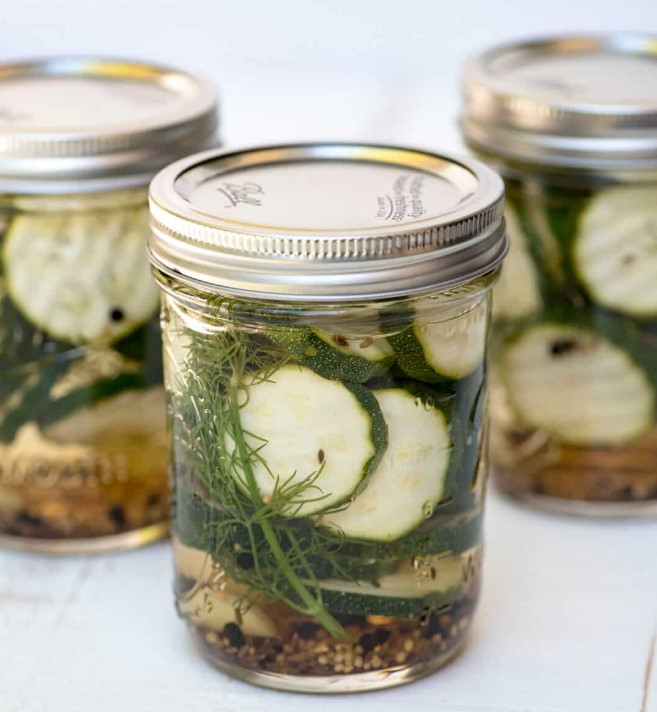
Ingredients
For the Pickles
3 garlic cloves, peeled and halved
1½ teaspoons black peppercorns
1½ teaspoons mustard seed
6 sprigs of fresh dill
700g courgettes
For the Brine
500ml water
250ml white vinegar
4 tablespoons sugar (I used muscovado)
2 tablespoons coarse sea salt
Method
Sterilise the jars in which you intend to store the pickles by pouring boiling water over them; you’ll need about 4 normal-sized jam jars or the equivalent. (See note below, as well.)
Divide the garlic, peppercorns, mustard seed and dill between them.
Wash, top and tail the courgettes. Slice into circles or spears, as you prefer, and pack neatly into the jars. Leave a bit of space at the top of each jar, so the courgettes can be covered completely in the brine.
Heat the brine ingredients over medium-high heat in a saucepan and boil until the sugar and salt dissolve.
Carefully pour the brine into your jars, put on the lids, and let cool to room temperature. (See note below, as well.)
Give the jars a good shake to distribute the spices and then store in the fridge for at least 24 hours before eating. They should last for some weeks.
NOTE: If the courgettes float to the surface you might want to weigh them down with something, to ensure they remain submerged in the brine, e.g. a smaller jam jar, ramekin dish etc. Make sure you sterilize these, too, with boiling water.
Recipe adapted from Valerie Brunmeier, Valerie’s Kitchen (2017)
A Recipe from Rebecca: Cumin-Scented Greens with Eggs, Feta, Lemon and Herbs
Shakshuka usually consists of eggs poached in a spicy tomato sauce. This is a green version, where the eggs are poached on top of a savoury mixture of cumin-scented greens, and then topped with feta, lemon and herbs. Serve it with good bread and some harissa if you’d like to spice it up a bit. Red or green, shakshuka is apparently a popular North African and Middle Eastern breakfast dish. It is also very nice for dinner, and uses only one pan.
We made it with some amazing duck eggs, which are huge and extra unctuous, so if you happen to have some lying around this is a good opportunity to use them. Ordinary eggs will be delicious too, though.
Green Shakshuka

Serves 2
Ingredients
3 tablespoons olive oil
1 large onion, roughly chopped
½ teaspoon salt
2 teaspoons cumin seed
1 teaspoon coriander seed
2 large garlic cloves, sliced thin
650-ishg greens (spinach, chard, spring greens, or a mixture), chopped
25g coriander, dill, mint, parsley, or a mixture, chopped
a wineglass (about 200ml) of white wine, or use water
2-4 eggs
100g feta, crumbled
half a lemon
Harissa and crusty bread, to serve
Method
Over medium heat, warm the oil in a frying pan and add the onion and salt. Reduce the heat to low and cook 5-10 minutes, or until the onion has softened.
While the onion is cooking toast the cumin and coriander seeds in a dry frying pan until fragrant. Keep an eye on it so it doesn’t burn. Set aside to cool a little and then grind it in a mortar and pestle (or use pre-ground spices).
Increase the heat back to medium and add the ground spices and garlic to the pan with the onion and stir for another minute or two, until it smells good.
Add the greens and most of the herbs—but keep a big handful of the herbs aside to use for a garnish. Stir everything together and sauté until the greens begin to wilt a bit. Add the wine or water, and cook for another 8-10 minutes, or until the greens are tender.
Once the greens are tender, use a spoon to create two to four little nests in the mass of cooked greens—one for each egg you intend to use. Crack each egg on the side of the pan, one at a time, and slide it into its nest. Cover the pan and cook for 4-6 minutes, or until the whites have set and the yolks are to your liking.
Remove from the heat and top with the feta. Grate the zest of the lemon onto the feta and then squeeze over the juice. Sprinkle with the remaining herbs and serve, with harissa and crusty bread.
Recipe adapted from BBC Good Food.
A Recipe from Rebecca: Spinach, Feta and Butter Beans
I recently listened to a fascinating episode of BBC Radio 4’s The Food Programme about ‘How Spain Does Beans’. The programme explained, among other things, why beans in a jar taste so good. Inspired by the programme I bought a jar of butter beans from Aubrey Allen. They cost more than beans from a tin, but they were really good. We’ve now eaten our way through several more jars, and I recommend them enormously for this or any recipe calling for butter beans. On the other hand, it’s also very, very good with ordinary tinned beans.
We ate this for diner with griddled asparagus and some roasted carrot and garlic mash.
Now, sorrel. If you can lay your hands on any of this fibrous, red-veined leaf, use it in place of some or all of the spinach. Since sorrel has its own sour, lemony flavour, you can reduce the lemon juice if you’re using sorrel.
Fried Butter beans with Feta, Sumac and Spinach or Sorrel
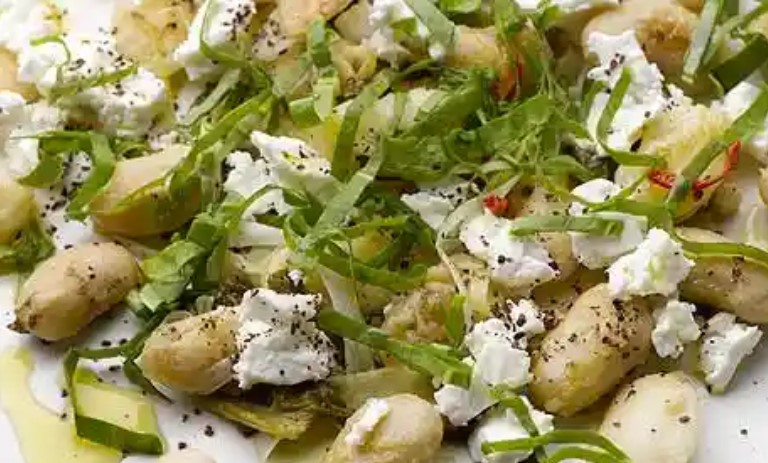
Serves 4.
Ingredients
60g butter
900g tinned or jarred butter beans, drained and rinsed
8 spring onions, halved lengthwise
1 garlic clove, peeled and mashed to a paste with ½ teaspoon salt
1-2 fresh red chiles, sliced thin (optional)
200g shredded spinach or, if you can get it, sorrel—or a mixture of both
3 tablespoons lemon juice (if you can get sorrel reduce this to about 1½ tablespoons)
150g feta, broken into pieces
2 teaspoons sumac
handful of chopped dill
olive oil, to drizzle over the top
Method
First fry the butter beans: heat a bit of the butter in a frying pan over medium-high heat. Add enough beans to cover the bottom of the pan in a single layer and fry for 1-2 minutes on each side, until the skin is golden brown and blistered. Remove to a large bowl and cook the remainder of the beans in the same fashion, adding more butter to the pan as necessary.
When the final batch of beans is almost done, add the spring onions, garlic, and chiles (if using), along with almost all of the spinach or sorrel. Keep back a little of the spinach or sorrel for a garnish.
Sauté everything together for another minute or two, and then return the other beans to the hot pan and mix everything together.
Remove from the heat and add the lemon juice. Scatter the feta over the top, sprinkle on the sumac, and top with the reserved spinach or sorrel, as well as the dill. Finish with a drizzle of olive oil and serve.
Recipe adapted from Yotam Ottolenghi, Plenty (2010).
Rebecca’s Recipe of the Week: Ukranian Borscht
Some of you may have seen that Russian chef Alissa Timoshkina has teamed up with Ukrainian chef Olia Hercules to raise money for Ukraine. I thought this week I would repeat this recipe for their excellent borscht.
Borscht
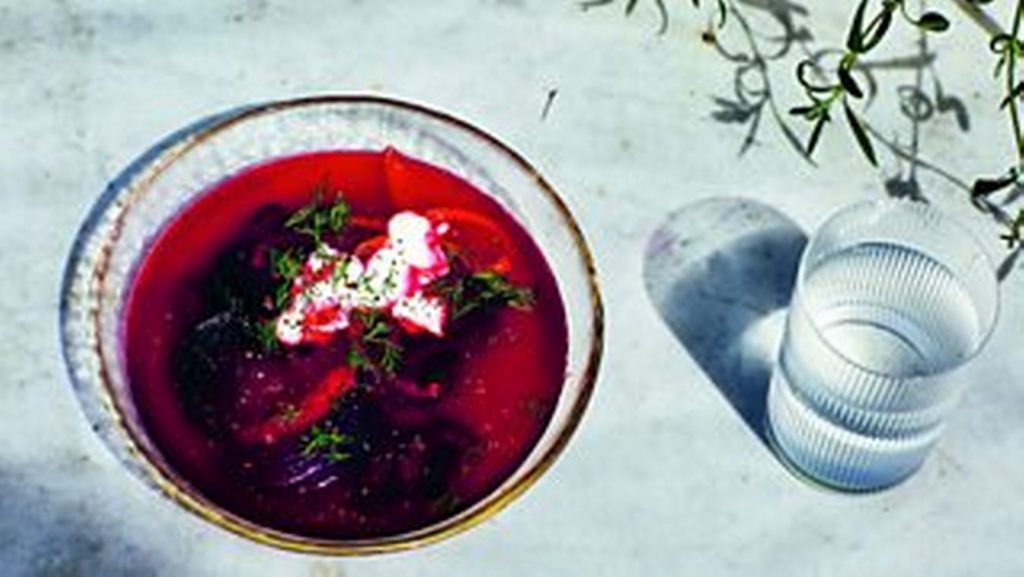
Serves 4
Ingredients
unrefined sunflower oil, for frying and roasting
1 large onion, finely diced
1 carrot, peeled and grated
6 raw beetroots
2 red peppers
2 tablespoons tomato purée
2 litres cold water
2 bay leaves
1 tablespoon black peppercorns
1 tablespoon coriander seeds
1 tablespoon fennel seeds
4 garlic cloves, peeled
bunch of dill
small bunch of flat leaf parsley
2 garlic cloves, grated
500g red cabbage sauerkraut
2 tablespoons pomegranate molasses
1 red onion
1 tablespoon brown sugar
400g can red kidney beans
2 teaspoons smoked paprika
4 tablespoons soured cream
salt
Preparation
Heat up a tablespoon of sunflower oil in a large pan and fry the onion and carrot for about 8 minutes until golden. Meanwhile, peel and grate 2 of the beetroots and core, deseed and thinly slice 1 red pepper. Add the vegetables to the pan together with the tomato purée and a splash of water. Season with salt to taste and fry for a further 5–8 minutes.
Top with the measured cold water, add the bay leaves along with the peppercorns and all the seeds, whole garlic cloves and half the bunches of dill and parsley. Season with a tablespoon of salt and bring to the boil. Reduce the heat, add the grated garlic and half the sauerkraut with its brine and simmer, covered, over a low heat for 40 minutes–1 hour.
Turn off the heat and let the borsch rest for another hour, while you prepare the rest of the elements.
So far, so good, but here is where the recipe starts to deviate from the norm quite a lot: to prepare the vegetables that will grace the plate and also add extra flavour and texture to the soup, you will need to do a bit of roasting.
Start by preheating the oven to 160°C fan/Gas Mark 4. Peel the remaining 4 beetroots, cut into wedges and dress with oil, salt and the pomegranate molasses. Peel the red onion, cut into wedges and season with salt and the brown sugar to bring out their sweetness and promote caramelization. Place on a roasting tray with the beetroot and roast together for 30 minutes. Drain the kidney beans, then dress them with salt, oil and the smoked paprika. Core and deseed the remaining red pepper, then cut into thin strips and dress with salt and oil. Roast the beans and pepper together, as they will need only 10–15 minutes.
When ready to serve, strain the broth through a sieve or a muslin cloth, discarding the solids. All we need is that rich broth! Reheat again if necessary. Next, create layers of texture and flavour in each bowl by adding a heaped tablespoon of the remaining sauerkraut to each, as well as a handful of roasted beetroot, onion, kidney beans and red pepper. Top each bowl with the hot broth and add a dollop of soured cream and a generous sprinkle of the remaining dill and parsley, chopped. The intensity of the flavours and textures of this dish is beyond words, while the look of the bowl will seduce the eye without a doubt.
Recipe from Alissa Timoshkina, Salt & Time: Recipes from a Russian Kitchen (2019).
Rebecca’s Recipe of the Week: A Lot of Cucumbers
What are you going to do with all those cucumbers? This salad is a tasty way to enjoy them. It combines a touch of sweetness from the dried fruit with feta’s salty kick, and the richness of toasted walnuts. Note the enormous quantity of sumac, which brings a bright, lemony note. We ate this for lunch along with some brown bread. It would probably also be good alongside a piece of grilled fish, or a little lamb chop.
Cucumber, Walnut, Feta and Dill
Serves 2 for lunch.
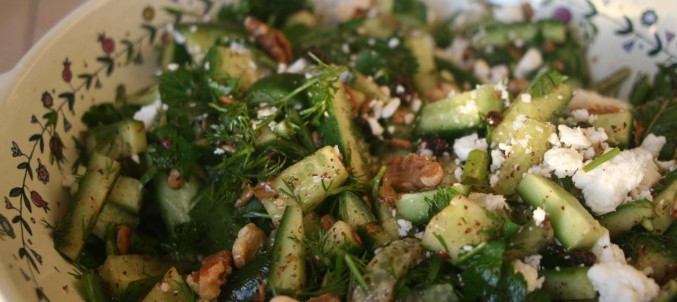
Ingredients
Salad
500g (or about 2) cucumbers, cut into matchsticks or spiralised
20g dill (or mixed dill and parsley), chopped
50g currants or golden raisins
100g feta, crumbled or cut into small cubes
60g walnut pieces, toasted and coarsely chopped
Dressing
2 tablespoon olive oil
zest of 1 lemon—zest it before you cut it in half to juice
1 tablespoon lemon juice
1 tablespoon sumac
½ teaspoon salt
several grinds of black pepper
Preparation
Gently toss the salad ingredients in a serving bowl.
Combine the dressing ingredients in a screw-top jar and shake vigorously. Pour over the salad and toss gently. Taste, add more salt or pepper to your liking, and serve.
Recipe adapted from Shaina Shealy, at Jewish Food Experience, 2021, https://jewishfoodexperience.com/recipes/cool-cucumber-salad-feta-walnuts/
Rebecca’s Recipe of the Week: Too Hot to Cook
Diana Henry includes this light and uplifting dish in a menu she calls ‘Too Hot to Cook’, which is exactly what it is right now. In truth the recipe involves a bit of cooking, since you have to sauté the carrots and beetroots, but only for about 2 minutes total, so it’s not too taxing. This is particularly good with the small, tender Canalside carrots we’re getting just now. She observes that ready-cooked beetroot is perfectly fine. (Just avoid the ones in vinegar.) Her version is a bit more elaborate insofar as it involves straining the yoghurt through a cloth for a few hours to make it a bit thicker before you mix it with the herbs and other seasonings. You can do that if you want.
In case you’re curious, the rest of her menu consists of roast tomatoes, fennel and chickpeas with preserved lemons and honey, and, for pudding, cherries in wine, with cardamom cream and rose pistachio shortbread. Yum!
Beetroots & Carrots with Cumin and Yoghurt
serves 4-6 as a starter
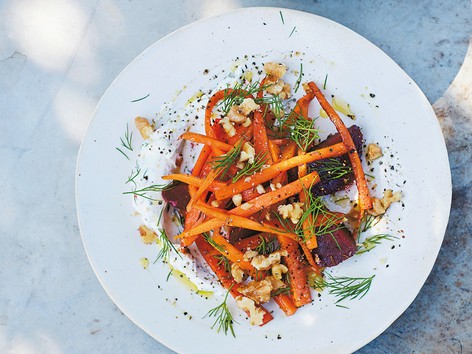
Ingredients
400g plain (full-fat) yoghurt
4 tablespoons olive oil
15g dill or coriander, roughly chopped
2 garlic gloves, peeled and crushed to a paste with a little salt in a mortar and pestle (optional)
¼ teaspoon Aleppo pepper (or to taste)—or use part of a chopped Canalside chile pepper
800g carrots
600g cooked beetroot
2 teaspoons cumin seeds
½ tablespoon white balsamic vinegar
½ lemon
25g walnuts, lightly toasted (optional)
Preparation
Mix the yoghurt with 2 tablespoons olive oil (i.e. not all of it!), most of the chopped herbs (keep a little back for a garnish), the crushed garlic and pepper. Swirl the yoghurt over the bottom of a serving plate and set aside.
Peel the carrots and cut them into thin matchsticks. Peel the beetroot and cut into slim wedges.
Heat 1 more tablespoon of olive oil in a large frying pan over medium heat. When it’s hot add 1 teaspoon of cumin seeds (i.e. not all of them!) and sizzle for about 30 seconds, then add the carrots. Stir-fry for about 1-2 minutes, or until they lose their rawness but still have some crispness to contrast with the soft beetroot. Add the white balsamic vinegar and a generous squeeze of lemon juice and season to taste with salt and pepper. Transfer to a bowl and return the pan to the heat.
Add the final tablespoon of olive oil and heat up as before. Add the remaining cumin seeds and again let sizzle before adding the beetroot. Cook for about 30 seconds, until they are heated through but not hot. Squeeze some more lemon juice over the top and season to taste with salt and pepper.
Array the beetroots over the yoghurt and then spoon on the carrots. Sprinkle the remaining herbs over the top and garnish with the walnuts (if you’re using them). Decorate with a final drizzle of olive oil and serve.
Recipe adapted from Diana Henry, How to Eat A Peach (2018).
Rob’s Recipe of the Week: Caramelised Cabbage
This recipe isn’t so Christmassy, but I did enjoy it. I found the liquid took a lot longer than stated to reduce, but in the end I would actually have preferred a bit more sauce when serving. Goes well with mash!
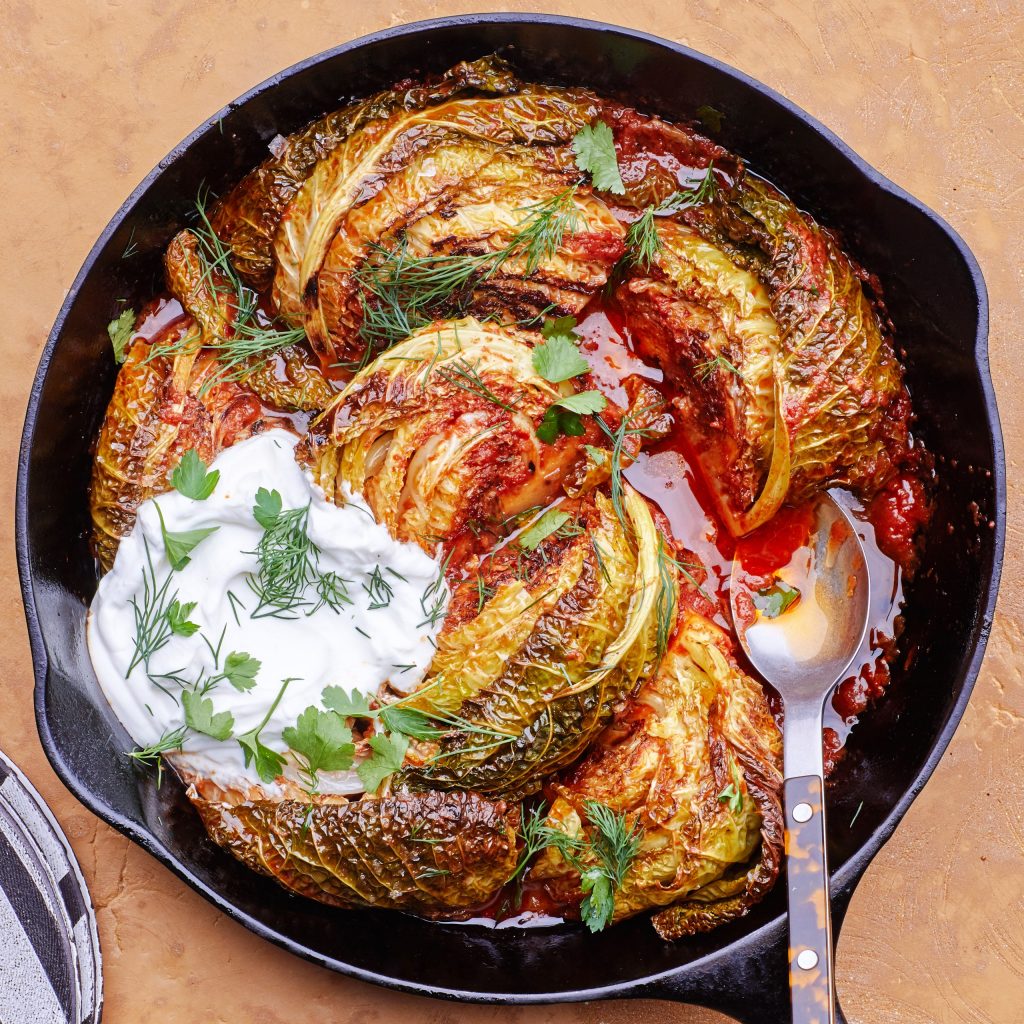
Ingredients
¼ cup double-concentrated tomato paste
3 garlic cloves, finely grated
1½ tsp. ground coriander
1½ tsp. ground cumin
1 tsp. crushed red pepper flakes
1 medium head of green cabbage
½ cup extra-virgin olive oil, divided
Salt
3 Tbsp. chopped dill, parsley, or coriander
Full-fat Greek yogurt or sour cream (for serving)
Method:
Preheat oven to 180°. Mix tomato paste, garlic, coriander, cumin, and red pepper flakes in a small bowl.
Cut cabbage in half through the core. Cut each half through the core into 4 wedges.
Heat ¼ cup oil in a large oven safe frying pan (or similar) over medium-high. Working in batches if needed, add cabbage to the pan cut side down and season with salt. Cook, turning occasionally, until lightly charred, about 4 minutes per side. Transfer cabbage to a plate.
Pour remaining ¼ cup oil into pan. Add spiced tomato paste and cook over medium heat, stirring frequently, until tomato paste begins to split and slightly darken, 2–3 minutes. Pour in enough water to come halfway up sides of pan (about 1½ cups), season with salt, and bring to a simmer. Nestle cabbage wedges back into skillet (they should have shrunk while browning; a bit of overlap is okay).
Transfer cabbage to oven and bake, uncovered and turning wedges halfway through, until very tender, liquid is mostly evaporated, and cabbage is caramelized around the edges, 40–50 minutes.
Scatter dill/other over cabbage. Serve with yogurt alongside.
From BonAppetit.com
Rob’s Recipe of the Week: Maintaining Courgette Enjoyment
Every summer I treat the first courgette with excitement but as I’m sure is the case for everyone, my enthusiasm begins to wane as the summer goes on. To try and help with this myself and Rebecca have been trying out some more courgette recipes. My favourite so far is courgette fritters (sorry there’s a bit of a fritter theme at the moment!), they made for a reasonably quick work-from-home lunch.
Courgette fritters
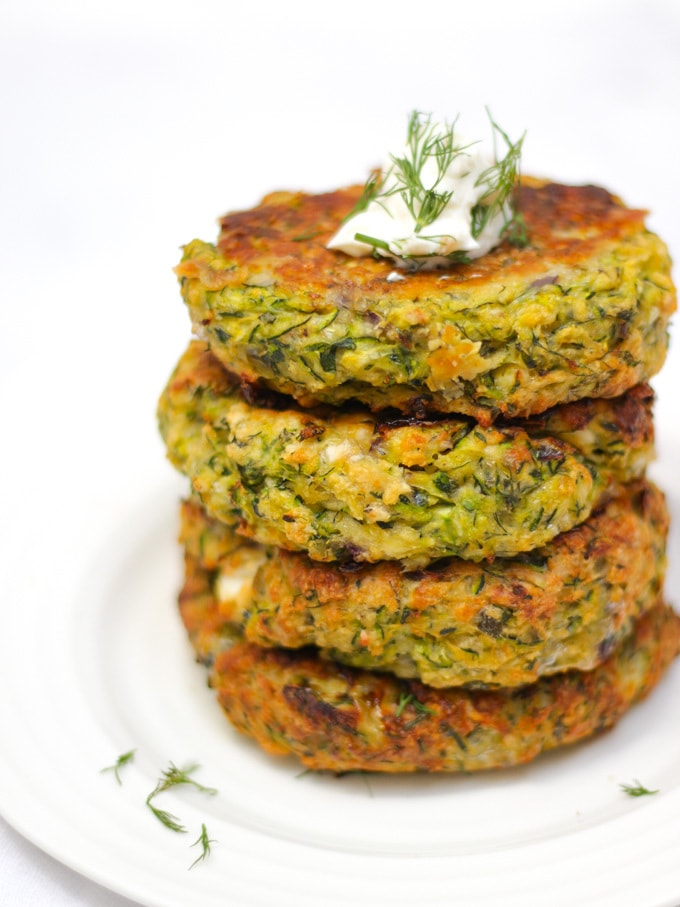
Ingredients (8 fritters):
1 kg Courgettes Grated
100 g Feta cheese Crumbled into big chunks
2 Medium free range eggs
2 Cloves Garlic Peeled and crushed
15 g Fresh dill Chopped
15 g Fresh mint Chopped
1 tsp Dried oregano
75 g Plain flour
200 g Breadcrumbs
1/2 Red onion Peeled and finely chopped
Fry light spray or Olive oil for greasing
Method:
Preheat the oven to 220C
Take your grated courgettes and over a colander, squeeze out as much of the liquid as you can. Use the colander and your hands, there will be lots!
When you’ve squeezed out the liquid, put all of your courgette fritter ingredients into a large bowl and mix well with clean hands.
Shape into 8 patties and put onto a greased (or sprayed using Fry Light) baking sheet. I got the strongest shapes by compacting a firm ball and then squash down into a disc
Bake for about 30 minutes of until browned, firm and cooked through (I fried them instead to speed things up)
From: https://www.tamingtwins.com/courgette-fritters-recipe/
Rebecca’s Recipe of the Week: Lebanese Tabouli
When I was growing up, tabouli formed part of my father’s very limited cooking repertoire, alongside steak tartare and chicken marsala. The recipe he used called it ‘non-lettuce salad’, and that’s a good description of this blend of parsley, mint, tomatoes, cucumbers and a little bulgar wheat. I dedicate this recipe to him!
The secret to this tabouli is the Lebanese 7-spice blend. For an absolute feast, serve it with Lebanese 7-spice chicken. It’s pretty good on its own, too.
Lebanese Tabouli
Serves 4
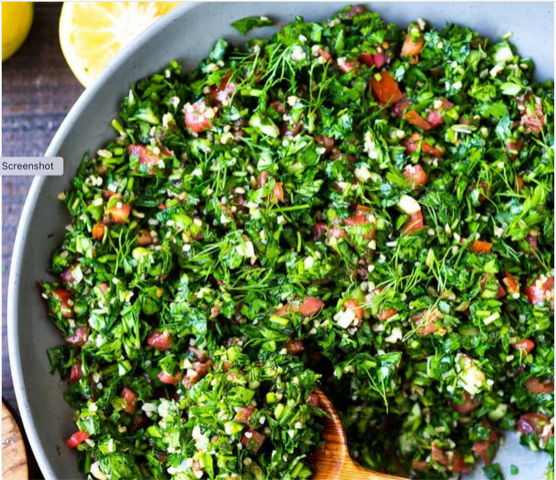
Ingredients
7 Spice Blend Ingredients
1 teaspoon ground coriander
1 teaspoon cumin
1 teaspoon cinnamon
1 teaspoon ground allspice
1/2 teaspoon grated nutmeg
1/2 teaspoon ground cloves
1/2 teaspoon ground cardamom
Tabouli ingredients
250ml dry medium grain bulgar wheat
4 spring onions
1 large bunch flat-leaf parsley
1 cup mint leaves
1 small bunch dill
3 medium tomatoes
1 cucumber
1 tablespoon lemon zest
70ml lemon juice, or to taste
125ml cup olive oil
1 teaspoon salt
1 teaspoon 7-Spice mix
Preparation
First prepare the 7-spice blend. This will make more than you need for the tabouli, but that shouldn’t be a problem since it’s so delicious. You can add it to lots of other things, including this splendid Lebanese 7-spice chicken. To make the blend combine all the ingredients together. If you want really to go to town with it, you can roast whole coriander and cumin seeds and then grind them, before combining with the other ingredients. This gives an added warm depth to the spice blend.
To make the salad, first prepare the bulgar wheat. Put it in a small bowl and pour 250ml boiling water over it. Cover with a plate, and set aside for at least 30 minutes while you prepare the rest of the salad. This allows the grains to soften.
Slice the spring onion and place in a large serving bowl.
Chop the parsley as fine as you can. It’s ok to include the thinner stems. Add to the bowl. Chop the mint and dill and add them as well.
Dice the tomatoes and cucumbers into small cubes and add them to the bowl, along with all their juices.
Add the lemon zest, lemon juice, olive oil, salt and 1 teaspoon of the 7-spice mix. Give it all a good stir.
By now 30 minutes have probably passed, so the bulgar wheat should be al dente. Once it is, add it to the salad as well and mix again.
If you have time, let the salad sit for a few hours to allow the flavours to meld. The parsley will soften and the bulgar will soak up the flavourful juices. It will in any event be very good the next day if there is any left over.
Before serving, give a stir and taste for salt, lemon and 7-spice. Adjust to your liking. Slyvie Fountaine, whose recipe this is, says ‘You want just the faintest whiff of the spices, like a whisper’.
Recipe adapted from Sylvia Fountaine, ‘Feasting at Home’. https://www.feastingathome.com/lemony-tabouli-aka-tabbouleh/
Rob’s Recipe of the Week: Swedish Summer Sandwich
This week’s recipe is a little niche if you stick to the vegan recipe, especially now that IKEA has closed in Coventry, but it can be adapted with other seafood flavours (the most obvious being actual seafood e.g. prawns). At worst, at least I’m giving you a quick and easy vegan mayo recipe… It’s another that I picked up in Sweden and is an adaptation of the dish “Skagen” which is a sort of seafood toast topper/sandwich filler (£6 for a baguette in the Volvo canteen ouch!). For a while it was my absolute favourite breakfast when combined with cucumber, salad and tomatoes all of which will be abundant in the shares over summer.
Vegan Skagen
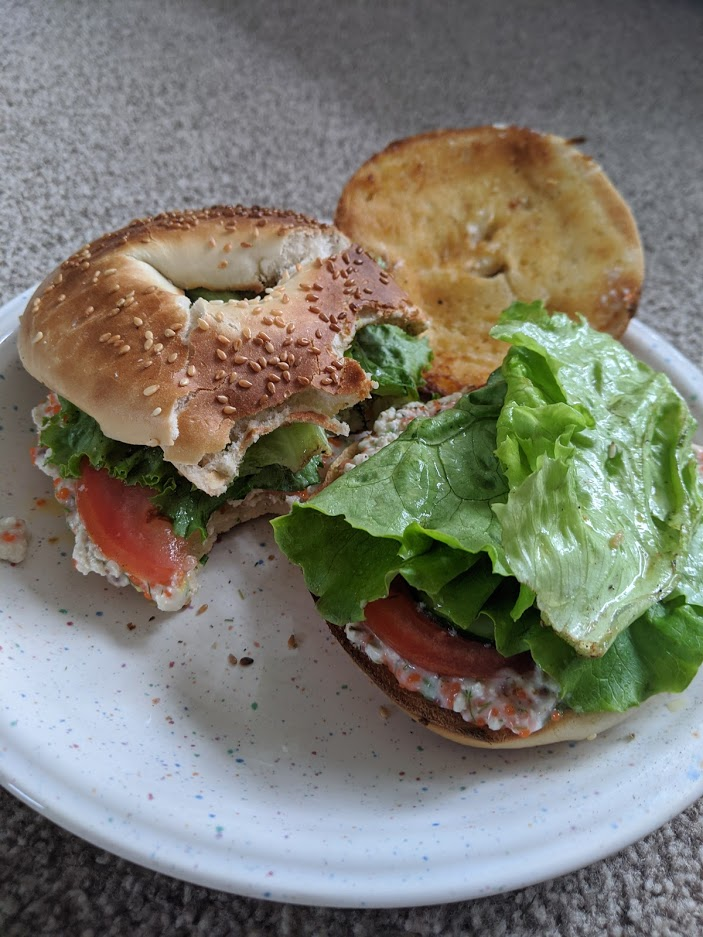
Dry Ingredients:
- 1 jar Seaweed pearls (AKA veggie caviar, available at IKEA)
- Bunch of dill
- 1 pack of tofu, drained and squeezed as much as possible whilst maintaining solid chunks
Mayo:
- 100ml Soya milk (must be soya – I’ve tried with others but they refused to emulsify with the oil)
- 1 tbsn lemon juice
- 1 tsp mustard
- 200 ml oil (preferably rapeseed, other veggie oils work but again can have trouble emulsifying)
To serve:
- Toast
- Lettuce
- Tomato
- Cucumber
- Wedge of lemon (optional)
Method:
For the mayo, combine milk, lemon juice and mustard in a blender (handheld will do) before SLOWLY adding oil as a thin stream whilst blending on a fairly high speed. As you get to the end of the oil the mixture should thicken up to a mayonnaise texture.
Then combine all ingredients in some Tupperware and serve with toast, sliced cucumber/tomato and lettuce. A lemon wedge is a nice addition if you have it.